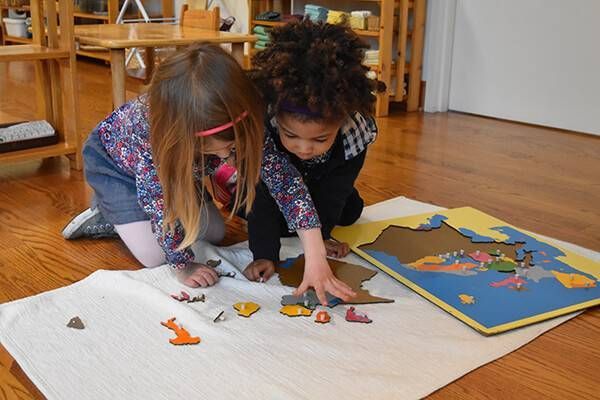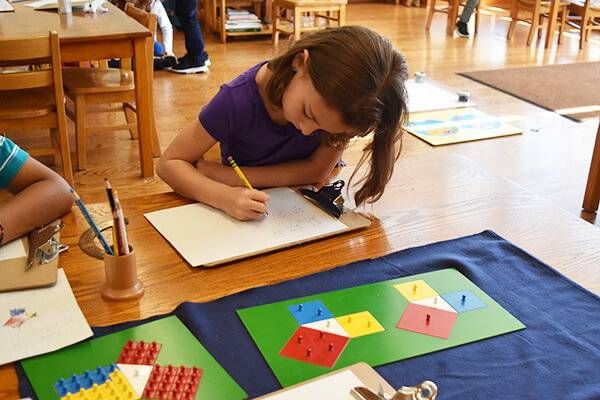
Normalization is one of the most important and most misunderstood terms in the Montessori philosophy. It is an objective of the Montessori curriculum. In fact, some might say it is the highest objective of the curriculum. Dr. Maria Montessori herself wrote, “It is the most important single result of our whole work” (Montessori, 1995, p. 204). The goal of the Montessori environment is to create this outcome. All roads lead to normalization. But what is it? And why does it matter?
What is it not?
To clear up any confusion, it is important to first address what normalization is not. Normalization does not mean being “normal.” Dr. Montessori wrote that her work was not intended for the creation of a “normal man” (Montessori, 1996, p. 34). It does not mean that children should strive towards societal, cultural, or even familial norms. Normalization is not about trying to make children the same or making them conform to imposed standards. It is not about removing children’s uniqueness or perfecting them towards some ideal. What’s more, it is not anything that adults “do” to children.
What is it?
Normalization was a phenomenon that Dr. Montessori observed in children who had been working constructively in her environment. It is a positive state of being that the children themselves bring about by their own activity. Dr. Montessori noticed that after a student had engaged in productive work, they emerged peaceful, joyful, and confident. For a period of time, they were free of what she referred to as “deviations,” defined in her own words simply as “the naughtiness of small children” (Montessori, 1996, p. 35).
A child who is normalized is helpful and kind. They are disciplined, independent, and accept the limits of living in a community. Their body and mind are fully integrated. It represents a child’s true nature, complete with their uniqueness. Normalized children do not all look and act the same, but they have similar attributes that allow them to lead with their strengths. Dr. Montessori wrote, “One is tempted to say that the children are performing spiritual exercises, having found the path of self-perfectionment and of ascent to the inner heights of the soul” (Montessori, 1995, p. 207). This lofty language refers to the spiritual quality of normalization—the inner development of a child’s best self.
How is normalization reached?
Normalization is achieved through concentration. Dr. Montessori observed that periods of deep and engaging activity brought children to this state. She wrote “[Normalization] always follows a piece of work done by the hands with real things, work accompanied by mental concentration” (Montessori, 1995, p. 204). After children work, they reveal their true and best nature. But how to encourage this kind of activity?

The Montessori classroom is unique in its ability to support the process of normalization. It offers children interesting and productive work that is relevant to their interests, abilities, and development. The teacher introduces children to this work, connecting them to materials that will be most meaningful for them. Then, the children are given the freedom to choose between different appropriate activities. When they have choices, they are able to select the work that will engage them fully. Dr. Montessori stated, “The essential thing is for the task to arouse such an interest that it engages the child’s whole personality” (Montessori, 1995, p. 206). Choice ensures that it will be their most satisfactory activity. Given time and space with this work, the children will concentrate.
It is after these periods of concentration that normalization emerges. Just as Dr. Montessori observed over one hundred years ago, research now shows that children in Montessori schools do in fact display the traits associated with normalization, including positive social development and greater executive functioning (Lillard and Else-Quest, 2006). Children in a Montessori classroom will have many opportunities for concentration, further strengthening their experience in that normalized state, and allowing it to become part of their character.
What can parents do at home to support normalization?
A child’s house should be their home. This means that a home should not be a replica of a classroom or try to imitate all the activities and qualities of a Montessori classroom. However, there are important ways that home life can support normalization at school. First is to ensure that children of all ages have plenty of opportunities for independent play and exploration. This kind of play should be unstructured and active. Screens and other forms of passive entertainment greatly undermine these kinds of activities, as they do nothing to support concentration or creativity.
Secondly, the home life should also have clear expectations of appropriate behavior. While these guidelines will be different from those in the classroom, consistent boundaries give children the security and discipline necessary for the development of normalization in their lives.
What does it look like at different ages?
Normalization is a productive point of departure. Dr. Montessori wrote, “Only ‘normalized’ children, aided by their environment, show in their subsequent development those wonderful powers that we describe; spontaneous discipline, continuous and happy work, social sentiments of help and sympathy for others” (Montessori, 1995, p. 206-207). It is not a permanent state, especially for a young child. There will be brief periods of normalization for young children, and these periods will eventually grow longer as children mature and spend more time in concentration with relevant work. Some children may experience normalization more easily than others. It is important that parents and teachers recognize that it is a process. Children will be inconsistent in their behavior as they will sometimes exhibit normalization and then will go through periods where they do not.

In the elementary years, normalization becomes more common. Children are capable of great intellectual work, and they will use this interest and ability to concentrate deeply on work that engages them. During this time, the positive traits of normalization become more of who they are. Through adolescence, Dr. Montessori recognized that normalization appeared as “valorization.” A normalized adolescent feels capable, strong, and worthy. Beyond adolescence, the hope is that normalization has been internalized into a person’s character. A normalized human being is a contributing member of society.
Why does it matter?
On a practical level, normalization creates goodness. Someone who is normalized feels happy and content. They are helpful to other people and contribute to their community. On a global level, normalization matters because of the profound inner change it can bring about in humanity. Peaceful people can bring about a peaceful civilization. Dr. Montessori was nominated three times for the Nobel Peace Prize in recognition of her work. The Montessori philosophy works on one child at a time, but, given enough time, that may be enough. Montessori is an “education for peace.” And normalization is a road to peace.
References
Lillard, A. S., & Else-Quest, N. (2006). Evaluating Montessori education. Science, 313, 1893-1894. doi: 10.1126/science.1132362
Montessori, M. (1995). The absorbent mind. New York: Henry Holt and Company.
Montessori, M. (1996). The formation of man. Oxford: Clio Press.


